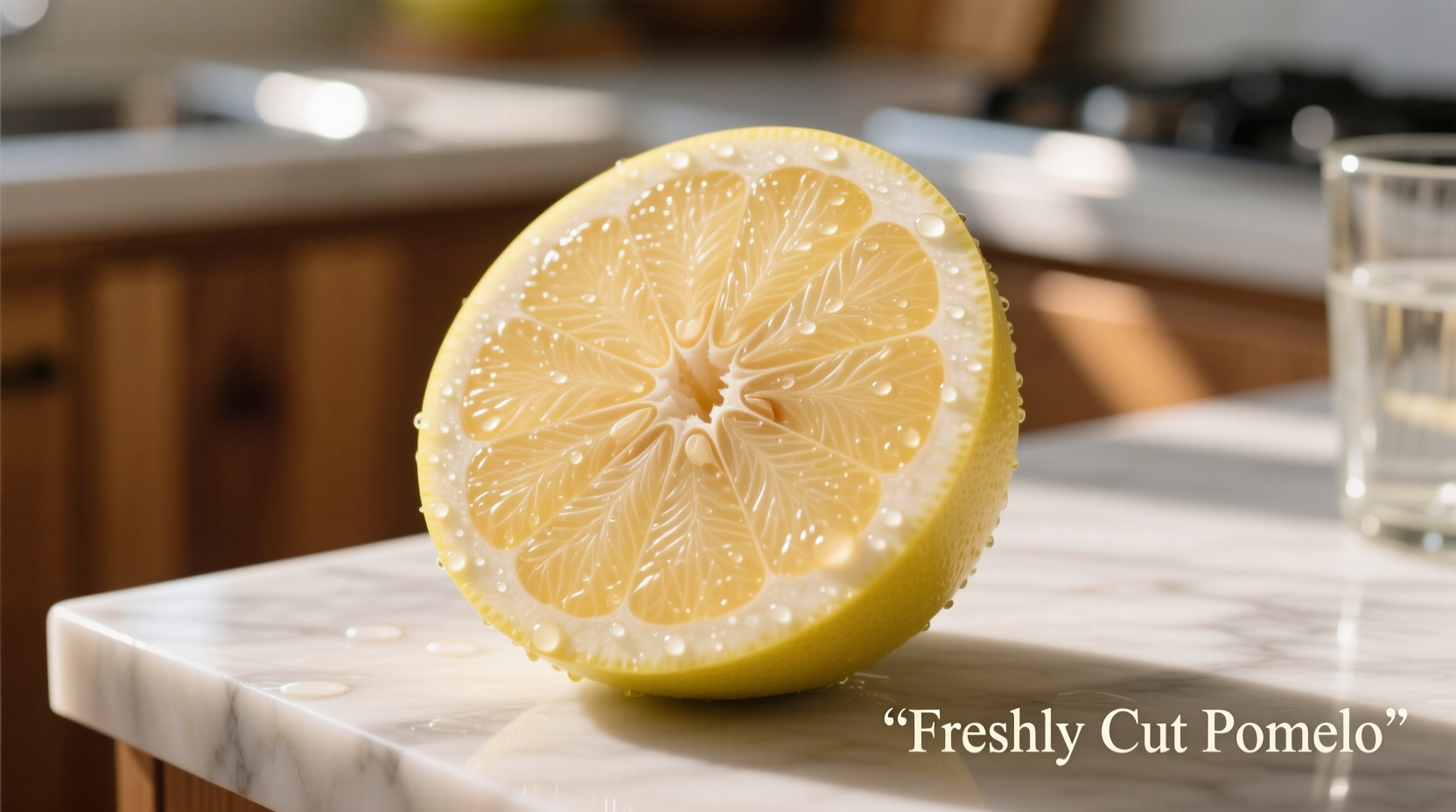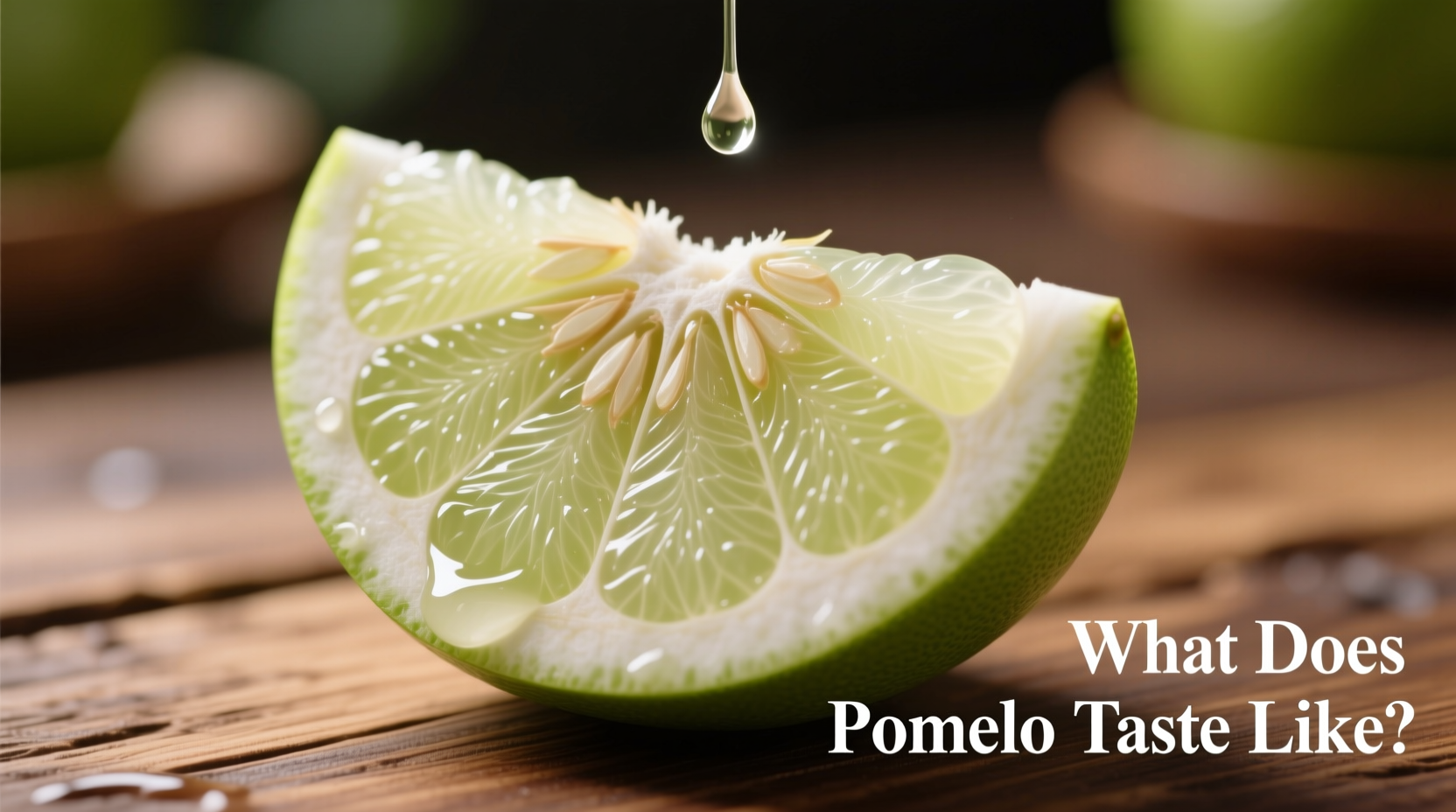When you first slice into a pomelo, you're greeted with a refreshing citrus aroma that's noticeably less intense than grapefruit. The flesh itself offers a gentle sweetness balanced with mild acidity, creating a harmonious flavor profile that appeals to even those who typically avoid bitter citrus varieties. Unlike its descendant grapefruit, pomelo contains minimal bitterness—typically registering between 0.5-1.0% citric acid compared to grapefruit's 1.0-1.5%, according to USDA agricultural research.
Understanding Pomelo's Flavor Profile
Pomelo (Citrus maxima) delivers a unique sensory experience that sets it apart from other citrus fruits. The taste can be described as:
- Sweetness level: Mild to moderately sweet, with Brix (sugar content) typically ranging from 8-12°Bx
- Acidity: Noticeable but gentle citric tang that complements rather than overwhelms
- Bitterness: Minimal—significantly less than grapefruit due to lower naringin content
- Texture: Crisp, juicy segments with a slightly thicker membrane than oranges
- Aroma: Subtle floral notes with hints of honey and tropical fruit
When properly ripe, pomelo offers a clean, refreshing taste that's neither cloyingly sweet nor aggressively tart. The white pith surrounding the segments is extremely bitter, but the fruit segments themselves maintain their pleasant flavor when separated carefully from this protective layer.
| Citrus Fruit | Sweetness Level | Bitterness Level | Acidity | Flavor Notes |
|---|---|---|---|---|
| Pomelo | Moderate (8-12°Bx) | Low | Mild | Sweet citrus, floral, subtle honey |
| Grapefruit | Moderate to low (6-10°Bx) | High | High | Tart citrus, pronounced bitterness |
| Orange | High (10-14°Bx) | None | Moderate | Bright citrus, straightforward sweetness |
| Mandarin | High (11-15°Bx) | None | Low | Honeyed, floral, less acidic |
How Pomelo Differs From Grapefruit
Many people confuse pomelo with grapefruit, but they're distinctly different fruits. While grapefruit is actually a hybrid of pomelo and sweet orange, pomelo maintains a more delicate flavor profile. Pomelo's sweetness emerges more prominently, with bitterness reduced to background notes rather than the dominant characteristic found in most grapefruit varieties.
University of California's Citrus Research Center confirms that pomelo contains significantly lower concentrations of naringin—the flavonoid responsible for grapefruit's characteristic bitterness. This biochemical difference explains why pomelo appeals to those who typically avoid grapefruit due to its intense bitterness.

Factors That Influence Pomelo Flavor
Several elements affect how your pomelo will taste, helping you select the best fruit for your preferences:
Ripeness Level
Unlike many fruits, pomelo doesn't continue ripening significantly after harvest. The ideal pomelo feels heavy for its size with slightly yielding skin. Overripe pomelos develop a fermented taste, while underripe specimens remain excessively tart. The sweet spot occurs when the greenish-yellow skin develops a subtle golden hue.
Varietal Differences
Different pomelo varieties offer distinct flavor profiles:
- Chandler: Sweetest variety with pale yellow flesh and minimal bitterness
- Forbidden: Deep pink flesh with berry-like notes and moderate sweetness
- Imperial: Balanced sweetness and acidity with traditional pomelo flavor
- Webber: More acidic with vibrant pink flesh and tropical undertones
Regional Growing Conditions
Pomelo grown in Southeast Asia—its native region—typically develops more complex flavor notes compared to those cultivated in Mediterranean climates. Thai pomelos often exhibit subtle honey notes, while Chinese varieties tend toward cleaner citrus flavors. The University of Florida's Institute of Food and Agricultural Sciences notes that soil composition and climate directly impact the fruit's terpene profile, which influences its aromatic qualities.
How to Select the Best Tasting Pomelo
Follow these practical guidelines to ensure you get the most flavorful pomelo:
- Weight test: Choose fruits that feel heavy for their size, indicating high juice content
- Skin inspection: Look for smooth, slightly glossy skin without soft spots or blemishes
- Color cues: Yellowish specimens generally taste sweeter than green ones
- Seasonality: Peak season runs from winter through early spring for optimal flavor
- Aroma check: Ripe pomelos emit a faint, sweet citrus fragrance at the stem end
Preparing Pomelo to Enhance Its Natural Flavor
How you prepare pomelo significantly impacts your tasting experience:
- Careful peeling: Remove only the outer rind and bitter white pith, preserving the membrane around segments
- Segment separation: Gently pull segments apart rather than cutting through membranes
- Chilling: Refrigerate for 1-2 hours before serving to enhance sweetness perception
- Serving temperature: Enjoy slightly cool (not ice-cold) to maximize flavor appreciation
- Simple presentation: Serve plain or with a light sprinkle of Tajín for those who enjoy a flavor boost
Avoid adding sugar—properly ripe pomelo needs no sweetener. If you find bitterness, you've likely included some of the white pith during preparation. The fruit's natural sugars become more pronounced when served at the right temperature with minimal handling.
Common Misconceptions About Pomelo Taste
Several myths persist about pomelo's flavor profile:
- Myth: Pomelo tastes just like grapefruit Reality: While related, pomelo is significantly sweeter and less bitter
- Myth: All pomelos are extremely tart Reality: Properly ripe specimens offer balanced sweetness
- Myth: The pink-fleshed varieties are sweeter Reality: Color doesn't reliably indicate sweetness—yellow varieties can be equally sweet
- Myth: Pomelo must be sweetened to be enjoyable Reality: High-quality pomelo stands perfectly on its own
Practical Ways to Enjoy Pomelo's Unique Flavor
Once you've experienced pomelo's distinctive taste, try these serving suggestions that highlight its natural qualities:
- As a refreshing standalone snack—the ultimate test of quality pomelo
- In fruit salads with complementary flavors like dragon fruit and mint
- Paired with seafood in ceviche for a bright citrus accent
- With a light sprinkle of Tajín for those who enjoy a flavor boost
- In desserts where its mild flavor won't overpower other ingredients
Remember that pomelo's delicate flavor works best when not competing with stronger ingredients. Its subtle sweetness shines when given center stage rather than being masked by more assertive flavors.
Frequently Asked Questions
Is pomelo sweeter than grapefruit?
Yes, pomelo is generally sweeter and significantly less bitter than grapefruit. While grapefruit contains higher levels of naringin (the compound responsible for bitterness), pomelo offers a more balanced sweet-tart profile with subtle floral notes. This makes pomelo more approachable for those who typically avoid grapefruit due to its pronounced bitterness.
Why does my pomelo taste bitter?
Bitterness usually occurs when the white pith or membranes are consumed along with the fruit segments. Pomelo's protective pith is extremely bitter, so careful preparation is essential. Underripe pomelos can also taste more tart and slightly bitter. To avoid bitterness, remove all white pith during preparation and select fruits that feel heavy for their size with slightly yielding skin.
How can I tell if a pomelo is sweet before buying?
Look for pomelos that feel heavy for their size (indicating high juice content), have slightly glossy skin, and show a transition from green to yellow. Ripe pomelos often emit a faint sweet citrus aroma at the stem end. Avoid fruits with soft spots, blemishes, or overly thick rinds, which can indicate lower quality. The heaviest specimens within a similar size range typically contain the most developed sugars.
Does pomelo taste different when chilled?
Yes, temperature significantly affects pomelo's flavor perception. Chilling pomelo enhances the perception of sweetness while reducing the perception of acidity. For optimal flavor, refrigerate pomelo for 1-2 hours before serving, but avoid serving it ice-cold as extremely low temperatures can mute the delicate flavor notes. The ideal serving temperature allows all flavor components to shine through clearly.











 浙公网安备
33010002000092号
浙公网安备
33010002000092号 浙B2-20120091-4
浙B2-20120091-4